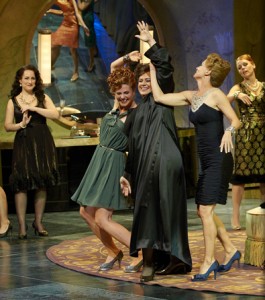by Jenna Rocca
The Canadian Opera Company’s presentation of Aida for the first time in 25 years is the example of opera at its best. Based on a French text by Camille du Locle, taken from a scenario by Auguste Mariette, it is considered by many to be Giuseppe Verdi‘s masterpiece, with the libretto by Antonio Ghislanzoni. It was first presented in 1871.
Following the class defying relationship between the great Egyptian warrior Radames and the servant Aida, the plot examines the internal conflict between romantic love and familial love; devotion to the heart or to the homeland.
With the incorporation of the archetypal “other woman,” Ameris played by a powerful Jill Grove, the culturally correct woman for Radames to marry, the drama thickens. Ameris at first taunts Aida while eventually making a transformation of her own by the end.
The wistful and lovelorn Aida is given full scope by the dove-like Michele Capalbo, who alternates with Sondra Radvanovsky. As in much of opera, the plot is very straightforward, a tale of tragic love that isn’t unfamiliar, but the music and the performers bring it to life with a full range of emotions and soul.
This is an ultimately tragic story interweaving devotion to self and to family and country: the bond to tradition and the natural inclination to be patriotic, contrasted with the optimism and new horizons intrinsic to love.
The orchestra, led by Johannes Debus, was flawless and full, working seamlessly with the singers. This production features six custom-made “Egyptian” style trumpets that play in A-flat and B-natural. They are long like “herald” trumpets, which most companies without the resources will use, but these are a bit brighter than a regular trumpet sounds and were made especially for the COC’s Aida. Their effect was not lost even amidst the opening of beautiful and terrifying war cries.
While originally set in ancient Egypt, this production brings the story to mid-century Egypt. In these kinds of modern interpretations locations and names become just words and the time and place, like the plot, really only serve as backdrop to the music and singers.
Not to say that I don’t love looking at things from the 60s: mod Go-Go dancer priestesses dance evocatively in a glass chest; it seems more like a peep show than a religious ceremony. They move in unison through red light and shadow. The head Priest guy (Ramfis, played by Phillip Ens) dressed and acting like Michael Madsen in Reservoir Dogs is kind of cool, but also kind of silly.
This is to say nothing of the gorgeous time-specific set, that truly evokes the mid-century lustre of the 1960s. The glory and glamour of gold and blue set off of one another is never lost on me.
Aida is a great first opera to see if you are new to it. I think that the gorgeous art direction and staging, and the sympathetic characters combined with distinct arias and emotionally charged orchestration make it very accessible. Someone I know was at the performance and it was her first opera, and she was very happily impressed with what she had seen by Intermission.
It is hard not to love this production and I encourage all newcomers to opera to give it a go.
Details:
– Aida will be performed at the Four Seasons Centre for the Performing Arts until Nov. 5, 2010
– tickets are available online
– are you under 30? the COC has a great program that makes opera affordable to the younger generation.

